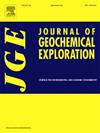Study on the effects of Fe/Al on the distribution and fate of rare earth elements during the mixing of acid mine drainage with karst river water
IF 3.3
2区 地球科学
Q1 GEOCHEMISTRY & GEOPHYSICS
引用次数: 0
Abstract
The geochemical behavior of rare earth elements (REEs) in acid mine drainage (AMD) has been extensively studied. However, the transport and fate of REEs during rapid mixing of AMD with karst river water (KRW), along with the factors influencing this process, remain uncertain. This study aimed to characterize the effects of hydrochemical parameters, particularly Fe and Al, on the distribution and fate of REEs in typical AMD-affected karst watersheds in northern Guizhou, China using geochemical modeling and structural equation modeling (SEM), Raman spectroscopy, transmission electron microscopy (TEM) and scanning electron microscopy-energy dispersive X-ray spectroscopy (SEM-EDS). The results showed that the pH of AMD was as low as 2.77, with the highest concentrations of Fe, Al and REEs were 428.50 mg/L, 57.68 mg/L and 2948.69 μg/L, respectively. When normalized to the North American Shale Composite (NASC), AMD samples exhibit enrichment patterns of MREEs (EMREE = +0.17 to +0.28). The results of the SEM revealed that Fe had a direct negative impact on REEs (β = −0.25). Raman spectroscopic analysis confirmed the presence of sulfate minerals (coquimbite and melanterite) and Fe-bearing phases (hematite) in the sediments. TEM and SEM-EDS analysis detected the presence of Fe-containing minerals (e.g., jarosite and goesite) in the sediments, indicating that REEs migration in AMD is predominantly controlled by Fe-phase minerals. After the rapid mixing of AMD and KRW, the pH increased to above 5, and a sharp decrease in the concentration of REEs in the water was observed. SEM analyses revealed that Al had a direct positive effect on the concentration of REEs (β = 0.90), while the effect of Fe was not obvious. The detected Al-/Fe-phase minerals (e.g., coquimbite, jarosite) in sediments and the mineral saturation indices (SI) indicated the precipitation tendencies for both phases, with Al-phases being dominant. This suggests that Al-phase play a crucial role in the distribution and migration of REEs. Through processes such as adsorption and co-precipitation, REEs are transferred to the sediments, ultimately leading the mixed water to exhibit a trend of LREEs enrichment. The findings from this research will enhance our understanding of the geochemical dynamics of REEs within the distinctive environmental context of karst watersheds influenced by AMD.
酸性矿山水与岩溶河水混合过程中Fe/Al对稀土元素分布及去向的影响研究
稀土元素在酸性矿井水中的地球化学行为已经得到了广泛的研究。然而,在AMD与喀斯特河水的快速混合过程中,稀土元素的运移和去向以及影响这一过程的因素仍不确定。利用地球化学模拟、结构方程模拟(SEM)、拉曼光谱、透射电子显微镜(TEM)和扫描电子显微镜-能量色散x射线能谱(SEM- eds)等方法,研究了黔北典型受amd影响的喀斯特流域水化学参数(特别是Fe和Al)对稀土元素分布和走向的影响。结果表明,AMD的pH低至2.77,Fe、Al和ree的最高浓度分别为428.50 mg/L、57.68 mg/L和2948.69 mg/L。当归一化到北美页岩复合材料(NASC)时,AMD样品显示出mree的富集模式(EMREE = +0.17至+0.28)。SEM结果表明,Fe对稀土元素有直接的负影响(β = - 0.25)。拉曼光谱分析证实了沉积物中存在硫酸盐矿物(coquimite和melanterite)和含铁相(赤铁矿)。TEM和SEM-EDS分析检测到沉积物中存在含铁矿物(如黄钾铁矾和goesite),表明AMD中稀土元素的迁移主要受铁相矿物控制。AMD与KRW快速混合后,pH升高至5以上,水中稀土元素浓度急剧下降。SEM分析表明,Al对稀土元素浓度有直接的正影响(β = 0.90),而Fe对稀土元素浓度的影响不明显。沉积物中检测到的Al / fe相矿物(如coquimite、黄钾铁矾)和矿物饱和度指数(SI)均显示出两相的沉淀趋势,以Al相为主。这表明al相在稀土元素的分布和迁移中起着至关重要的作用。稀土元素通过吸附和共沉淀等过程被转移到沉积物中,最终导致混合水呈现出lree富集的趋势。本研究结果将有助于我们进一步认识受AMD影响的喀斯特流域独特环境背景下稀土元素的地球化学动力学。
本文章由计算机程序翻译,如有差异,请以英文原文为准。
求助全文
约1分钟内获得全文
求助全文
来源期刊

Journal of Geochemical Exploration
地学-地球化学与地球物理
CiteScore
7.40
自引率
7.70%
发文量
148
审稿时长
8.1 months
期刊介绍:
Journal of Geochemical Exploration is mostly dedicated to publication of original studies in exploration and environmental geochemistry and related topics.
Contributions considered of prevalent interest for the journal include researches based on the application of innovative methods to:
define the genesis and the evolution of mineral deposits including transfer of elements in large-scale mineralized areas.
analyze complex systems at the boundaries between bio-geochemistry, metal transport and mineral accumulation.
evaluate effects of historical mining activities on the surface environment.
trace pollutant sources and define their fate and transport models in the near-surface and surface environments involving solid, fluid and aerial matrices.
assess and quantify natural and technogenic radioactivity in the environment.
determine geochemical anomalies and set baseline reference values using compositional data analysis, multivariate statistics and geo-spatial analysis.
assess the impacts of anthropogenic contamination on ecosystems and human health at local and regional scale to prioritize and classify risks through deterministic and stochastic approaches.
Papers dedicated to the presentation of newly developed methods in analytical geochemistry to be applied in the field or in laboratory are also within the topics of interest for the journal.
 求助内容:
求助内容: 应助结果提醒方式:
应助结果提醒方式:


